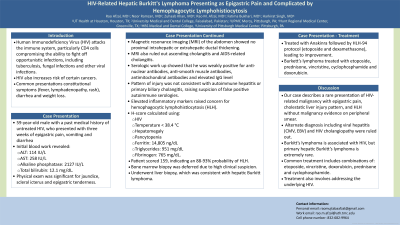Sunday Poster Session
Category: Liver
P1264 - HIV - Related Hepatic Burkitt's Lymphoma Presenting as Epigastric Pain and Complicated by Hemophagocytic Lymphohistiocytosis
Sunday, October 27, 2024
3:30 PM - 7:00 PM ET
Location: Exhibit Hall E

Has Audio

Rao Afzal, MD
University of Pittsburgh Medical Center - Mercy
Pittsburgh, PA
Presenting Author(s)
Rao Afzal, MD1, Noor Ul Huda Ramzan, MD2, Zuhaab U. Khan, MD1, Rao Mustafa Afzal, MD3, Fatima Bukhari, MBBS4, Harkirat Singh, MD5
1University of Pittsburgh Medical Center - Mercy, Pittsburgh, PA; 2University Medical and Dental College, Pittsburgh, PA; 3Hunt Regional Healthcare, Greenville, TX; 4Hazrat Bari Sarkar Medical and Dental College, Islamabad, Islamabad, Pakistan; 5University of Pittsburgh Medical Center, Pittsburgh, PA
Introduction: Human Immunodeficiency Virus (HIV), attacks the immune system, particularly CD4 cells. It compromises the ability to fight off opportunistic infections like tuberculosis, fungal infections and certain types of cancers. It commonly presents with constitutional symptoms like fever, lymphadenopathy, rash, diarrhea and weight loss.
Case Description/Methods: 59-year-old male with a history of untreated HIV presented with three weeks of epigastric pain, vomiting and diarrhea. Labs showed ALT 114 IU/L, AST 258 IU/L, ALP 2127 IU/L, and total bilirubin 12.1 mg/dL. Physical exam showed jaundice, scleral icterus and epigastric tenderness. Magnetic resonance imaging of the abdomen did not reveal proximal intrahepatic or extrahepatic ductal thickening, thus ruling out ascending cholangitis and AIDS-related cholangitis. He was weakly positive for anti-nuclear, anti-smooth muscle and anti-mitochondrial antibodies along with an elevated IgG. His pattern of injury was not consistent with autoimmune hepatitis or primary biliary cholangitis; therefore, it was suspected that his autoimmune serologies were falsely positive. Inflammatory markers were elevated, and in the context of immunosuppression, there was concern for hemophagocytic lymphohistiocytosis (HLH). H-score was used to calculate the probability of HLH using the following: HIV, temperature less than 38.4 °C, hepatomegaly, pancytopenia, ferritin 14805 ng/dL, triglycerides 951 mg/dL and fibrinogen 765 mg/dL. The patient scored 159 with 88-93% probability. A bone marrow biopsy was deferred given high clinical suspicion. Patient was treated with Anakinra followed by HLH-94 protocol with etoposide and dexamethasone, after which he showed improvement. He underwent a liver biopsy which was consistent with hepatic Burkitt lymphoma and treated with Etoposide, Prednisone, Vincristine, Cyclophosphamide and Doxorubicin.
Discussion: This case describes a rare presentation of HIV-related malignancy, manifesting as epigastric pain and cholestatic liver injury, along with HLH without evidence of malignancy on peripheral smear. Alternative diagnoses, such as viral hepatitis including Cytomegalovirus, Epstein-Barr virus and HIV cholangiopathy were ruled out. While Burkitt’s lymphoma is one of the malignancies associated with HIV, primary hepatic Burkitt lymphoma is an extremely rare type of extranodal lymphoma. It is commonly treated with combinations of Etoposide, Vincristine, Doxorubicin, Prednisone, and Cyclophosphamide, alongside addressing the underlying HIV.
Disclosures:
Rao Afzal, MD1, Noor Ul Huda Ramzan, MD2, Zuhaab U. Khan, MD1, Rao Mustafa Afzal, MD3, Fatima Bukhari, MBBS4, Harkirat Singh, MD5. P1264 - HIV - Related Hepatic Burkitt's Lymphoma Presenting as Epigastric Pain and Complicated by Hemophagocytic Lymphohistiocytosis, ACG 2024 Annual Scientific Meeting Abstracts. Philadelphia, PA: American College of Gastroenterology.
1University of Pittsburgh Medical Center - Mercy, Pittsburgh, PA; 2University Medical and Dental College, Pittsburgh, PA; 3Hunt Regional Healthcare, Greenville, TX; 4Hazrat Bari Sarkar Medical and Dental College, Islamabad, Islamabad, Pakistan; 5University of Pittsburgh Medical Center, Pittsburgh, PA
Introduction: Human Immunodeficiency Virus (HIV), attacks the immune system, particularly CD4 cells. It compromises the ability to fight off opportunistic infections like tuberculosis, fungal infections and certain types of cancers. It commonly presents with constitutional symptoms like fever, lymphadenopathy, rash, diarrhea and weight loss.
Case Description/Methods: 59-year-old male with a history of untreated HIV presented with three weeks of epigastric pain, vomiting and diarrhea. Labs showed ALT 114 IU/L, AST 258 IU/L, ALP 2127 IU/L, and total bilirubin 12.1 mg/dL. Physical exam showed jaundice, scleral icterus and epigastric tenderness. Magnetic resonance imaging of the abdomen did not reveal proximal intrahepatic or extrahepatic ductal thickening, thus ruling out ascending cholangitis and AIDS-related cholangitis. He was weakly positive for anti-nuclear, anti-smooth muscle and anti-mitochondrial antibodies along with an elevated IgG. His pattern of injury was not consistent with autoimmune hepatitis or primary biliary cholangitis; therefore, it was suspected that his autoimmune serologies were falsely positive. Inflammatory markers were elevated, and in the context of immunosuppression, there was concern for hemophagocytic lymphohistiocytosis (HLH). H-score was used to calculate the probability of HLH using the following: HIV, temperature less than 38.4 °C, hepatomegaly, pancytopenia, ferritin 14805 ng/dL, triglycerides 951 mg/dL and fibrinogen 765 mg/dL. The patient scored 159 with 88-93% probability. A bone marrow biopsy was deferred given high clinical suspicion. Patient was treated with Anakinra followed by HLH-94 protocol with etoposide and dexamethasone, after which he showed improvement. He underwent a liver biopsy which was consistent with hepatic Burkitt lymphoma and treated with Etoposide, Prednisone, Vincristine, Cyclophosphamide and Doxorubicin.
Discussion: This case describes a rare presentation of HIV-related malignancy, manifesting as epigastric pain and cholestatic liver injury, along with HLH without evidence of malignancy on peripheral smear. Alternative diagnoses, such as viral hepatitis including Cytomegalovirus, Epstein-Barr virus and HIV cholangiopathy were ruled out. While Burkitt’s lymphoma is one of the malignancies associated with HIV, primary hepatic Burkitt lymphoma is an extremely rare type of extranodal lymphoma. It is commonly treated with combinations of Etoposide, Vincristine, Doxorubicin, Prednisone, and Cyclophosphamide, alongside addressing the underlying HIV.
Disclosures:
Rao Afzal indicated no relevant financial relationships.
Noor Ul Huda Ramzan indicated no relevant financial relationships.
Zuhaab Khan indicated no relevant financial relationships.
Rao Mustafa Afzal indicated no relevant financial relationships.
Fatima Bukhari indicated no relevant financial relationships.
Harkirat Singh indicated no relevant financial relationships.
Rao Afzal, MD1, Noor Ul Huda Ramzan, MD2, Zuhaab U. Khan, MD1, Rao Mustafa Afzal, MD3, Fatima Bukhari, MBBS4, Harkirat Singh, MD5. P1264 - HIV - Related Hepatic Burkitt's Lymphoma Presenting as Epigastric Pain and Complicated by Hemophagocytic Lymphohistiocytosis, ACG 2024 Annual Scientific Meeting Abstracts. Philadelphia, PA: American College of Gastroenterology.
